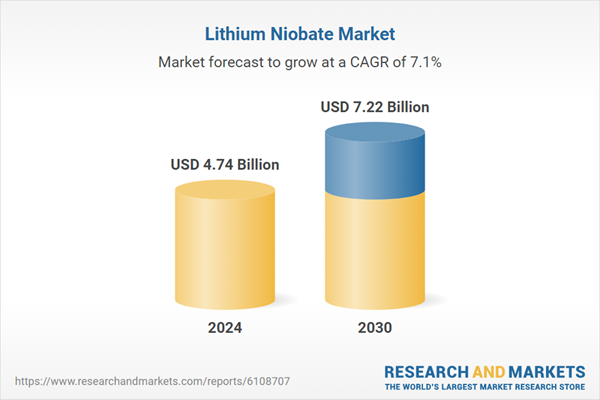Speak directly to the analyst to clarify any post sales queries you may have.
10% Free customizationThis report comes with 10% free customization, enabling you to add data that meets your specific business needs.
Rising adoption of 5G, fiber-optic networks, and high-speed data systems is fueling demand for lithium niobate-based components. In parallel, the development of thin-film lithium niobate (TFLN) and lithium-niobate-on-insulator (LNOI) platforms is enabling device miniaturization and energy-efficient photonic integration. These advancements are crucial for next-generation telecom and quantum photonics. Moreover, its durability and thermal stability position lithium niobate as a key material for advanced sensing and high-frequency applications in aerospace and defense, ensuring long-term strategic relevance across multiple industries.
Key Market Drivers
Proliferation of 5G and Telecom Infrastructure
The accelerated deployment of 5G infrastructure is significantly boosting the demand for lithium niobate-based optical modulators, vital for high-speed data transmission. As of 2023, more than 3.7 million 5G base stations have been installed globally, with Asia adding approximately 250,000 new stations each quarter. Optical transceivers operating at 200G and 400G speeds, heavily deployed in urban networks, rely on lithium niobate modulators in nearly 80% of cases.More than 60% of next-generation fiber backhaul systems utilize electro-optic devices made from lithium niobate. With over USD 270 billion invested globally in telecom upgrades, operators prioritize optical components that deliver high speed with minimal insertion loss - typically below 3 dB, a performance level that lithium niobate consistently achieves. These capabilities are driving its adoption as the material of choice in advanced 5G communication systems.
Key Market Challenges
High Manufacturing and Material Costs
The lithium niobate market faces notable cost challenges linked to the material's complex and resource-intensive production processes. High-purity crystals are grown using the Czochralski method, requiring precision equipment and significant energy input. The cost of key raw materials - lithium and niobium oxides - has escalated due to global supply chain pressures, pushing up production costs. Processing steps like wafer slicing, polishing, and nanofabrication demand specialized tools and expertise, further raising expenses.Transitioning to thin-film lithium niobate (TFLN) adds complexity, as it involves bonding and etching procedures that increase manufacturing overhead. Startups and smaller companies often struggle with these barriers due to limited capital and lower production volumes. In addition, the niche nature of lithium niobate reduces economies of scale compared to silicon-based platforms. These cost-related obstacles hinder adoption in budget-sensitive sectors like automotive and consumer electronics, pressuring suppliers to balance performance with affordability and sustain R&D investment despite margin constraints.
Key Market Trends
Growing Integration of Lithium Niobate in Quantum Photonics
The application of lithium niobate in quantum photonics is expanding rapidly due to its outstanding electro-optic and nonlinear optical characteristics, which are crucial for manipulating quantum light. It is being widely used in quantum communication, computing, and sensing technologies - particularly for generating entangled photons, performing modulation in QKD systems, and integrating optical functions onto quantum photonic circuits (QPICs).Institutions and startups across North America, Europe, and Asia are incorporating lithium niobate into chip-based quantum devices, with thin-film lithium niobate enabling high integration density and single-photon-level precision. National quantum strategies are also allocating funding to support lithium niobate research and commercialization, fostering collaborations among academic institutions, photonic foundries, and defense organizations. As demand grows for secure quantum networks and post-quantum encryption systems, lithium niobate's broadband transparency, thermal resilience, and scalability solidify its role as a foundational material in the evolving quantum technology ecosystem.
Key Market Players
- Sumitomo Metal Mining Co. Ltd.
- Shin Etsu Chemical Co. Ltd.
- Crystal Technology, Inc.
- Korth Kristalle GmbH
- EKSMA Optics
- Oxide Corporation
- Raicol Crystals Ltd.
- United Crystals, Inc.
- Coherent Corp.
- Fujitsu Optical Components
Report Scope:
In this report, the Global Lithium Niobate Market has been segmented into the following categories, in addition to the industry trends which have also been detailed below:Lithium Niobate Market, By Product Type:
- Optical Grade Lithium Niobate
- Acoustic Grade Lithium Niobate
Lithium Niobate Market, By Crystal Type:
- Z-cut Lithium Niobate
- X-cut Lithium Niobate
- Y-cut Lithium Niobate
- Others
Lithium Niobate Market, By Application:
- Telecommunication
- Consumer Electronics
- Defense & Aerospace
- Healthcare
- Others
Lithium Niobate Market, By Region:
- North America
- United States
- Canada
- Mexico
- Europe
- Germany
- France
- United Kingdom
- Italy
- Spain
- South America
- Brazil
- Argentina
- Colombia
- Asia-Pacific
- China
- India
- Japan
- South Korea
- Australia
- Middle East & Africa
- Saudi Arabia
- UAE
- South Africa
Competitive Landscape
Company Profiles: Detailed analysis of the major companies present in the Global Lithium Niobate Market.Available Customizations:
With the given market data, the publisher offers customizations according to a company's specific needs. The following customization options are available for the report.Company Information
- Detailed analysis and profiling of additional market players (up to five).
This product will be delivered within 1-3 business days.
Table of Contents
Companies Mentioned
- Sumitomo Metal Mining Co. Ltd.
- Shin‑Etsu Chemical Co. Ltd.
- Crystal Technology, Inc.
- Korth Kristalle GmbH
- EKSMA Optics
- Oxide Corporation
- Raicol Crystals Ltd.
- United Crystals, Inc.
- Coherent Corp.
- Fujitsu Optical Components
Table Information
| Report Attribute | Details |
|---|---|
| No. of Pages | 185 |
| Published | July 2025 |
| Forecast Period | 2024 - 2030 |
| Estimated Market Value ( USD | $ 4.74 Billion |
| Forecasted Market Value ( USD | $ 7.22 Billion |
| Compound Annual Growth Rate | 7.1% |
| Regions Covered | Global |
| No. of Companies Mentioned | 10 |









